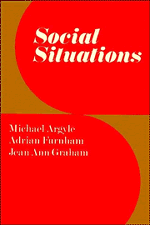Book contents
- Frontmatter
- Contents
- Preface
- 1 Introduction
- 2 The analysis of social situations
- 3 The effect of the situation on behaviour
- 4 Drives and goals
- 5 Rules
- 6 Role-systems
- 7 Repertoire of elements
- 8 Sequences of interaction
- 9 Concepts and cognitive structures
- 10 Environmental setting
- 11 Language and speech
- 12 Stressful situations
- 13 Applications of situational analysis
- 14 Conclusions
- References
- Names index
- Subject index
1 - Introduction
Published online by Cambridge University Press: 01 June 2011
- Frontmatter
- Contents
- Preface
- 1 Introduction
- 2 The analysis of social situations
- 3 The effect of the situation on behaviour
- 4 Drives and goals
- 5 Rules
- 6 Role-systems
- 7 Repertoire of elements
- 8 Sequences of interaction
- 9 Concepts and cognitive structures
- 10 Environmental setting
- 11 Language and speech
- 12 Stressful situations
- 13 Applications of situational analysis
- 14 Conclusions
- References
- Names index
- Subject index
Summary
A number of recent studies by Milgram, Zimbardo and others have demonstrated the extraordinary extent to which behaviour is affected by situations. If we want to explain and understand social behaviour we must explain how situations influence it.
The experiment by Milgram (1974) showed that normal members of the public would give what they thought were near-fatal electric shocks to another person in 65 per cent of cases, if ordered to do so by the experimenter. In the experiment by Zimbardo (1973) normal university students, who were asked to play the role of prison guards, did so in such a tyrannical way that others, students ordered to be convicts, became emotionally distressed, and the experiment had to be terminated. Studies of religious sects show that people who are quite normal on week-days can speak with tongues, handle snakes and have near-psychotic experiences on Sundays (Argyle and Beit-Hallahmi, 1975).
An account of experimental studies of the effects of situations on behaviour is given in Chapter 3.
Why we need to analyse situations
There are several reasons why it would be useful to understand situations better. In our work on social-skills training we frequently came across people who could not cope with particular social situations – for example, parties, committee meetings, ‘dates’ (Trower, Bryant and Argyle, 1978).
- Type
- Chapter
- Information
- Social Situations , pp. 1 - 11Publisher: Cambridge University PressPrint publication year: 1981

